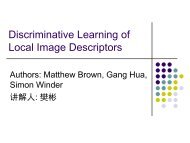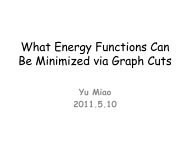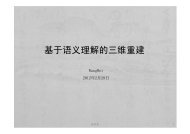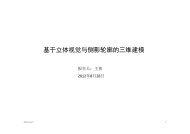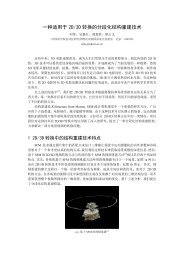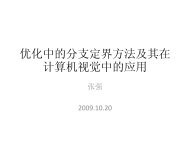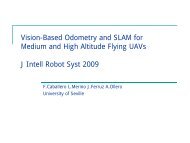Full article in PDF - Nguyen Dang Binh
Full article in PDF - Nguyen Dang Binh
Full article in PDF - Nguyen Dang Binh
You also want an ePaper? Increase the reach of your titles
YUMPU automatically turns print PDFs into web optimized ePapers that Google loves.
Camera Calibration from the Quasi-aff<strong>in</strong>e<br />
Invariance of Two Parallel Circles<br />
Yihong Wu, Haijiang Zhu, Zhanyi Hu, and Fuchao Wu<br />
National Laboratory of Pattern Recognition, Institute of Automation,<br />
Ch<strong>in</strong>ese Academy of Sciences, P.O. Box 2728, Beij<strong>in</strong>g 100080, P.R. Ch<strong>in</strong>a<br />
{yhwu,hjzhu,huzy,fcwu}@nlpr.ia.ac.cn<br />
Abstract. In this paper, a new camera calibration algorithm is proposed,<br />
which is from the quasi-aff<strong>in</strong>e <strong>in</strong>variance of two parallel circles.<br />
Two parallel circles here mean two circles <strong>in</strong> one plane, or <strong>in</strong> two parallel<br />
planes. They are quite common <strong>in</strong> our life.<br />
Between two parallel circles and their images under a perspective projection,<br />
we set up a quasi-aff<strong>in</strong>e <strong>in</strong>variance. Especially, if their images<br />
under a perspective projection are separate, we f<strong>in</strong>d out an <strong>in</strong>terest<strong>in</strong>g<br />
distribution of the images and the virtual <strong>in</strong>tersections of the images,<br />
and prove that it is a quasi-aff<strong>in</strong>e <strong>in</strong>variance.<br />
The quasi-aff<strong>in</strong>e <strong>in</strong>variance is very useful which is applied to identify the<br />
images of circular po<strong>in</strong>ts. After the images of the circular po<strong>in</strong>ts are identified,<br />
l<strong>in</strong>ear equations on the <strong>in</strong>tr<strong>in</strong>sic parameters are established, from<br />
which a camera calibration algorithm is proposed. We perform both simulated<br />
and real experiments to verify it. The results validate this method<br />
and show its accuracy and robustness. Compared with the methods <strong>in</strong><br />
the past literatures, the advantages of this calibration method are: it is<br />
from parallel circles with m<strong>in</strong>imal number; it is simple by virtue of the<br />
proposed quasi-aff<strong>in</strong>e <strong>in</strong>variance; it does not need any match<strong>in</strong>g.<br />
Except<strong>in</strong>g its application on camera calibration, the proposed quasiaff<strong>in</strong>e<br />
<strong>in</strong>variance can also be used to remove the ambiguity of recover<strong>in</strong>g<br />
the geometry of s<strong>in</strong>gle axis motions by conic fitt<strong>in</strong>g method <strong>in</strong> [8] and<br />
[9]. In the two literatures, three conics are needed to remove the ambiguity<br />
of their method. While, two conics are enough to remove it if the<br />
two conics are separate and the quasi-aff<strong>in</strong>e <strong>in</strong>variance proposed by us is<br />
taken <strong>in</strong>to account.<br />
1 Introduction<br />
Camera calibration is an important task <strong>in</strong> computer vision whose aim is to estimate<br />
the camera parameters. Usually, camera self-calibration techniques without<br />
prior knowledge on camera parameters are nonl<strong>in</strong>ear [4], [13], [15]. It can be l<strong>in</strong>earized<br />
if some scene <strong>in</strong>formation is taken <strong>in</strong>to account dur<strong>in</strong>g the process of<br />
calibration. Therefore, it has been appear<strong>in</strong>g a lot of calibration methods us<strong>in</strong>g<br />
scene constra<strong>in</strong>ts [2], [3], [5], [10], [11], [12], [14], [18], [19], [20], [23], [24],<br />
[25]. Usually, the used <strong>in</strong>formation <strong>in</strong> the scene is parallels, orthogonality, or<br />
T. Pajdla and J. Matas (Eds.): ECCV 2004, LNCS 3021, pp. 190–202, 2004.<br />
c○ Spr<strong>in</strong>ger-Verlag Berl<strong>in</strong> Heidelberg 2004
Camera Calibration from the Quasi-aff<strong>in</strong>e Invariance of Two Parallel Circles 191<br />
the known angles, circles and their centers, concentric conics et al. For example,<br />
<strong>in</strong> [14], the images of circular po<strong>in</strong>ts are determ<strong>in</strong>ed when there is a circle<br />
with several diameters <strong>in</strong> the scene, then the l<strong>in</strong>ear constra<strong>in</strong>ts on the <strong>in</strong>tr<strong>in</strong>sic<br />
parameters are set up. In [2], by us<strong>in</strong>g the parallel and orthogonal properties<br />
of the scene, the constra<strong>in</strong>ts on the projective matrix are given. Parallelepipeds<br />
with some known angles and length ratios of the sides are assumed existed, then<br />
from them the equations on the <strong>in</strong>tr<strong>in</strong>sic parameters are established <strong>in</strong> [20]. [25]<br />
presents a calibration method us<strong>in</strong>g one-dimensional objects.<br />
Our idea <strong>in</strong> this paper is also to use the scene <strong>in</strong>formation to f<strong>in</strong>d the constra<strong>in</strong>ts<br />
on the <strong>in</strong>tr<strong>in</strong>sic parameters of cameras. Two circles <strong>in</strong> one plane or <strong>in</strong> two<br />
parallel planes, called two parallel circles, are assumed to be <strong>in</strong> the scene, and<br />
then a quasi-aff<strong>in</strong>e <strong>in</strong>variance of them is found. Based on the <strong>in</strong>variance, camera<br />
calibration is <strong>in</strong>vestigated, and a new algorithm is proposed. Compared with the<br />
previous methods, this method has the follow<strong>in</strong>g advantages: it is from parallel<br />
circles with m<strong>in</strong>imal number; it is simple by virtue of the proposed quasi-aff<strong>in</strong>e<br />
<strong>in</strong>variance; it does not need any match<strong>in</strong>g.<br />
The parallel circles are quite common <strong>in</strong> our life, and then this calibration<br />
method can be applied. It can also be used to solve the ambiguity for recover<strong>in</strong>g<br />
the geometry of s<strong>in</strong>gle axis motions <strong>in</strong> [8], [9]. The two literatures have shown<br />
that the geometry of s<strong>in</strong>gle axis motion can be recovered given at least two<br />
conic loci consist<strong>in</strong>g of correspond<strong>in</strong>g image po<strong>in</strong>ts over multiple views. If the<br />
two conics are separate or enclos<strong>in</strong>g, the recovery has a two fold ambiguity, the<br />
ambiguity is removed by us<strong>in</strong>g three conics <strong>in</strong> the literatures. In fact, if the two<br />
conics are separate, it is enough to remove the ambiguity only from the two<br />
conics by tak<strong>in</strong>g <strong>in</strong>to account the quasi-aff<strong>in</strong>e <strong>in</strong>variance presented <strong>in</strong> this paper.<br />
On the other hand, <strong>in</strong> [16], Quan gave the <strong>in</strong>variants of two space conics.<br />
When the two conics are parallel circles, this <strong>in</strong>variants cannot be set up, but a<br />
quasi-aff<strong>in</strong>e <strong>in</strong>variance proposed <strong>in</strong> this paper <strong>in</strong>deed exists. Actually, the imag<strong>in</strong>g<br />
process of a p<strong>in</strong>hole camera is quasi-aff<strong>in</strong>e [6], [7], the proposed quasi-aff<strong>in</strong>e<br />
<strong>in</strong>variance is very useful.<br />
The paper is organized as follows. Section 2 is some prelim<strong>in</strong>aries. Section<br />
3 uses a quasi-aff<strong>in</strong>e <strong>in</strong>variance of two parallel circles to establish the equations<br />
on the camera <strong>in</strong>tr<strong>in</strong>sic parameters, and gives a l<strong>in</strong>ear algorithm for calibrat<strong>in</strong>g<br />
a camera from these equations. Then, the <strong>in</strong>variance and algorithm are validated<br />
from both simulated and real experiments <strong>in</strong> Section 4. Conclusions and<br />
acknowledgements are remarked <strong>in</strong> Section 5 and 6 respectively.<br />
2 Prelim<strong>in</strong>aries<br />
In this paper, ”≈” denotes the equality up to a scale, a capital bold letter<br />
denotes a matrix or a 3D homogeneous coord<strong>in</strong>ates, a small bold letter denotes<br />
a 2D homogeneous coord<strong>in</strong>ates.<br />
Def<strong>in</strong>ition 1. If two circles <strong>in</strong> space are <strong>in</strong> one plane, or <strong>in</strong> two parallel planes<br />
respectively, we call them two parallel circles.
192 Y. Wu et al.<br />
C 2<br />
C 3 C 1<br />
Fig. 1. Parallel circles. C1 and C3 are coplanar, C2 is <strong>in</strong> the plane parallel to the plane<br />
conta<strong>in</strong><strong>in</strong>g C1 and C3. Any two of them are two parallel circles<br />
See Fig. 1, C1, C2, C3 are parallel circles each other.<br />
Under a p<strong>in</strong>hole camera, a po<strong>in</strong>t X <strong>in</strong> space is projected to a po<strong>in</strong>t x <strong>in</strong> the<br />
image by:<br />
x ≈ K[R, t]X, (1)<br />
where K is the 3 × 3 matrix of camera <strong>in</strong>tr<strong>in</strong>sic parameters, R isa3× 3 rotation<br />
matrix, t is a 3D translation vector. The goal of calibrat<strong>in</strong>g a camera is to f<strong>in</strong>d<br />
K from images.<br />
The absolute conic consists of po<strong>in</strong>ts X =(X1,X2,X3, 0) at <strong>in</strong>f<strong>in</strong>ity such<br />
that:<br />
X 2 1 + X 2 2 + X 2 3 =0, or, X τ X =0,<br />
and its image ω is:<br />
x τ K −τ K −1 x =0. (2)<br />
If some po<strong>in</strong>ts on ω can be <strong>in</strong>ferred from image, the equations on the <strong>in</strong>tr<strong>in</strong>sic<br />
parameters can be set up by (2). If the number of these equations is enough,<br />
the <strong>in</strong>tr<strong>in</strong>sic parameters will be determ<strong>in</strong>ed. In the follow<strong>in</strong>g, we are to f<strong>in</strong>d the<br />
po<strong>in</strong>ts on ω by us<strong>in</strong>g two parallel circles <strong>in</strong> the scene.<br />
Some prelim<strong>in</strong>aries on projective geometry are needed, the readers can refer<br />
to the details <strong>in</strong> [17]. Every real plane other than the plane at <strong>in</strong>f<strong>in</strong>ity, denoted<br />
by P , <strong>in</strong>tersects the plane at <strong>in</strong>f<strong>in</strong>ity at a real l<strong>in</strong>e, called the l<strong>in</strong>e at <strong>in</strong>f<strong>in</strong>ity<br />
of P , denoted by L0. L0 <strong>in</strong>tersects the absolute conic at a pair of conjugate<br />
complex po<strong>in</strong>ts, called the circular po<strong>in</strong>ts of P . Every circle <strong>in</strong> P passes through<br />
the circular po<strong>in</strong>ts of P . Let C1 and C2 be two parallel circles, P1 and P2 be<br />
the parallel planes conta<strong>in</strong><strong>in</strong>g them. Because P1 and P2 have the same l<strong>in</strong>e at<br />
<strong>in</strong>f<strong>in</strong>ity, they have the same pair of circular po<strong>in</strong>ts. Therefore, C1 and C2 pass<br />
through the same pair of circular po<strong>in</strong>ts, they and the absolute conic form a<br />
coaxial conic system at the two circular po<strong>in</strong>ts (A coaxial conic system means a<br />
set of conics through two fixed po<strong>in</strong>ts).<br />
A quasi-aff<strong>in</strong>e transformation lies part way between a projective and aff<strong>in</strong>e<br />
transformation, which preserves the convex hull of a set of po<strong>in</strong>ts, and the relative
Camera Calibration from the Quasi-aff<strong>in</strong>e Invariance of Two Parallel Circles 193<br />
positions of some po<strong>in</strong>ts and l<strong>in</strong>es <strong>in</strong> a plane, or the relative positions of some<br />
po<strong>in</strong>ts and planes <strong>in</strong> 3D space. For the details, see [7] or Chapter 20 <strong>in</strong> [6].<br />
3 New Calibration Method from the Quasi-aff<strong>in</strong>e<br />
Invariance of Two Parallel Circles<br />
Under a p<strong>in</strong>hole camera, a circle is projected to a conic. Moreover, because K,<br />
R, t <strong>in</strong> (1) are real, a real po<strong>in</strong>t is projected to a real po<strong>in</strong>t, and a pair of<br />
conjugate complex is projected to a pair of conjugate complex. So the images of<br />
a pair of circular po<strong>in</strong>ts must still be a pair of conjugate complex.<br />
If there are three or more than three parallel circles <strong>in</strong> the scene, then from<br />
their images, the images of a pair of circular po<strong>in</strong>ts can be uniquely determ<strong>in</strong>ed<br />
without any ambiguity by solv<strong>in</strong>g for the <strong>in</strong>tersection po<strong>in</strong>ts of the three image<br />
conics [8], [21]. If there are only two ones <strong>in</strong> the scene, denoted by C1, C2, whose<br />
images are denoted by c1, c2, whether the images of a pair of circular po<strong>in</strong>ts can<br />
be uniquely determ<strong>in</strong>ed or not depends on the relative positions of c1 and c2.<br />
The equations for c1, c2 are two quadric equations, the number of their common<br />
solutions over complex field is four with multiplicity. If there are real solutions<br />
among these four ones, or c1 and c2 have real <strong>in</strong>tersections, then there is a unique<br />
pair of conjugate complex among these four solutions, which must be the images<br />
of the pair of circular po<strong>in</strong>ts. If c1 and c2 have no real <strong>in</strong>tersection, these four<br />
solutions are two pairs of conjugate complex. Which pair is the images of the<br />
circular po<strong>in</strong>ts? We will discuss it <strong>in</strong> the follow<strong>in</strong>g.<br />
c 1 c 2<br />
c 2 c 1<br />
Fig. 2. Two cases that c1 and c2 have no real <strong>in</strong>tersection: the left side is the separate<br />
case; the right side is the enclos<strong>in</strong>g case<br />
If the relative positions of the camera and circles <strong>in</strong> the scene are <strong>in</strong> general,<br />
or, the circles lie entirely <strong>in</strong> front of the camera, the images of these circles are<br />
ellipses. From now, we always regard that the circles <strong>in</strong> the scene are entirely <strong>in</strong><br />
front of the camera. Then, when c1 and c2 have no real <strong>in</strong>tersection, there are<br />
two cases as shown <strong>in</strong> Fig. 2, one case is that c1 and c2 separate; another case is<br />
that c1 and c2 enclose. For the enclos<strong>in</strong>g case, we can not dist<strong>in</strong>guish the images<br />
of the circular po<strong>in</strong>ts between the two pairs of conjugate complex <strong>in</strong>tersections<br />
of c1 and c2 [21]. While, for the separate case, we can dist<strong>in</strong>guish them by a<br />
quasi-aff<strong>in</strong>e <strong>in</strong>variance.
194 Y. Wu et al.<br />
Firstly, a lemma with respect to two coplanar circles is needed. In order to<br />
dist<strong>in</strong>guish notations of two coplanar circles from the above notations C1 and<br />
C2 of two parallel circles, we denote two coplanar circles as C1 and C3.<br />
Lemma 1. If C1 and C3 are two coplanar separate circles, their homogeneous<br />
equations have two pairs of conjugate complex common solutions. We connect<br />
the two po<strong>in</strong>ts <strong>in</strong> each pair of the conjugate complex common solutions, then<br />
obta<strong>in</strong> two real l<strong>in</strong>es, called the associated l<strong>in</strong>es of C1 and C3. One of the two<br />
associated l<strong>in</strong>es lies between C1 and C3, and the other one, which is the l<strong>in</strong>e at<br />
<strong>in</strong>f<strong>in</strong>ity pass<strong>in</strong>g through the circular po<strong>in</strong>ts, does not lie between C1 and C3 as<br />
shown <strong>in</strong> Fig. 3.<br />
The proof of Lemma 1 is given <strong>in</strong> Appendix.<br />
C 1<br />
Y<br />
O<br />
L 1<br />
L 0<br />
1 X 0 - R<br />
The l<strong>in</strong>e at <strong>in</strong>f<strong>in</strong>ity<br />
Fig. 3. Two coplanar separate circles C1, C3, and their associated l<strong>in</strong>es L1 and L0<br />
(the l<strong>in</strong>e at <strong>in</strong>f<strong>in</strong>ity). C1 and C3 <strong>in</strong>tersect at two pairs of conjugate complex po<strong>in</strong>ts,<br />
one pair is on the l<strong>in</strong>e L1; another pair, which is the pair of circular po<strong>in</strong>ts, is on the<br />
l<strong>in</strong>e at <strong>in</strong>f<strong>in</strong>ity L0. L1 lies between C1 and C3, while, L0 does not<br />
Theorem 1. If c1, c2 are the images of two parallel circles and separate, their<br />
homogeneous equations have two pairs of conjugate complex common solutions.<br />
We connect the two po<strong>in</strong>ts <strong>in</strong> each pair of the conjugate complex common solutions,<br />
then obta<strong>in</strong> two real l<strong>in</strong>es, called the associated l<strong>in</strong>es of c1 and c2. One<br />
of the two associated l<strong>in</strong>es lies between c1 and c2, and the other one does not<br />
lie between c1 and c2 as shown <strong>in</strong> Fig. 4. If the camera optical center does not<br />
lie between the two parallel planes conta<strong>in</strong><strong>in</strong>g the two circles, the associated l<strong>in</strong>e<br />
not ly<strong>in</strong>g between c1 and c2 is the vanish<strong>in</strong>g l<strong>in</strong>e through the images of circular<br />
po<strong>in</strong>ts. Otherwise, the associated l<strong>in</strong>e ly<strong>in</strong>g between c1 and c2 is the vanish<strong>in</strong>g<br />
l<strong>in</strong>e through the images of circular po<strong>in</strong>ts.<br />
R<br />
X 0<br />
C 3<br />
X
Camera Calibration from the Quasi-aff<strong>in</strong>e Invariance of Two Parallel Circles 195<br />
c 1<br />
c 2<br />
l 1 l 0<br />
Fig. 4. The distributions of c1, c2, and their two associated l<strong>in</strong>es l1 and l0. c1 and c2<br />
<strong>in</strong>tersect at two pairs of conjugate complex po<strong>in</strong>ts, one pair is on the l<strong>in</strong>e l1; another<br />
pair is on the l<strong>in</strong>e l0. l1 lies between c1 and c2, while, l0 does not. The images of<br />
circular po<strong>in</strong>ts are the pair on l0 if the optical center does not lie between the two<br />
parallel planes conta<strong>in</strong><strong>in</strong>g the two circles. Otherwise, they are the pair on l1<br />
Proof. Let the two parallel circles be C1, C2, and P1, P2 be the planes conta<strong>in</strong><strong>in</strong>g<br />
them, O be the camera optical center. Because P1, P2 are parallel, the quadric<br />
cone with O as its vertex and pass<strong>in</strong>g through C2 <strong>in</strong>tersects the plane P1 at a<br />
circle, denoted by C3. C1 and C3 are two coplanar circles <strong>in</strong> P1. Because c1 and<br />
c2 are separate, and are also the images of C1 and C3, we know that C1 and C3<br />
are separate too. See Fig. 5. By Lemma 1, there is the fact: one of the associated<br />
l<strong>in</strong>es of C1 and C3 lies between C1 and C3 (denoted by L), and the other one,<br />
i.e. the l<strong>in</strong>e at <strong>in</strong>f<strong>in</strong>ity pass<strong>in</strong>g through the circular po<strong>in</strong>ts, does not lie between<br />
C1 and C3 (denoted by L0).<br />
If O does not lie between P1 and P2, we know that C1, C3 <strong>in</strong> P1 are all <strong>in</strong><br />
front of the camera. Because under a p<strong>in</strong>hole camera, the imag<strong>in</strong>g process from<br />
the parts of P1 <strong>in</strong> front of the camera to the image plane is quasi-aff<strong>in</strong>e ([7],<br />
Chapter 20 <strong>in</strong> [6]), the relative positions of c1, c2 and their associated l<strong>in</strong>es are<br />
the same as the ones of C1, C3, L, L0. So the associated l<strong>in</strong>e not ly<strong>in</strong>g between<br />
c1 and c2 is the images of L0, i.e. the vanish<strong>in</strong>g l<strong>in</strong>e through the images of the<br />
circular po<strong>in</strong>ts.<br />
If O lies between P1 and P2, the plane through O and L0, denoted by P0,<br />
which is parallel to P1 and P2, lies between C1 and C2. And, the plane through<br />
O and L, denoted by P , does not lie between C1 and C2. This is because C3<br />
and C1 lie on the different sides of P , and also C3 and C2 lie on the different<br />
sides of P . The projection from C1, C2, P0, P to their images is quasi-aff<strong>in</strong>e, so<br />
c1, c2 and their associated l<strong>in</strong>es have the same relative positions as the ones of<br />
C1, C2, P0, P (The image of P0 is the vanish<strong>in</strong>g l<strong>in</strong>e ly<strong>in</strong>g between c1 and c2,<br />
the image of P is the associated l<strong>in</strong>e not ly<strong>in</strong>g between c1 and c2).<br />
Then, the theorem is proved.<br />
Therefore, if c1 and c2 are separate, by Theorem 1, we can f<strong>in</strong>d out the<br />
images of a pair of circular po<strong>in</strong>ts. If c1 and c2 are enclos<strong>in</strong>g, and their two<br />
pairs of conjugate complex <strong>in</strong>tersections do not co<strong>in</strong>cide, we can not f<strong>in</strong>d out the<br />
images of circular po<strong>in</strong>ts now (if the two pairs of conjugate complex <strong>in</strong>tersections
196 Y. Wu et al.<br />
C 2<br />
O<br />
C 3<br />
The camera optical center<br />
Fig. 5. The camera and two parallel circles C1, C2. O is the camera optical center. The<br />
quadric cone pass<strong>in</strong>g through O (as the vertex) and C2 <strong>in</strong>tersects the plane conta<strong>in</strong><strong>in</strong>g<br />
C1 at another circle C3. C1 and C3 are coplanar. If the images of C1 and C2 are<br />
separate, C1 and C3 are separate too because the image of C3 is the same as the<br />
image of C2<br />
co<strong>in</strong>cide to one pair, the co<strong>in</strong>cid<strong>in</strong>g pair is the images of circular po<strong>in</strong>ts, and at<br />
the time, C1, C3 are concentric) [21].<br />
In fact, the enclos<strong>in</strong>g case of c1 and c2 usually seldom occurs, and other<br />
cases of c1 and c2 occur quite often <strong>in</strong> our life. We regard that c1 and c2 are not<br />
enclos<strong>in</strong>g below.<br />
By the discussion <strong>in</strong> the second paragraph <strong>in</strong> this section and Theorem 1, the<br />
images of a pair of circular po<strong>in</strong>ts can always be determ<strong>in</strong>ed from a s<strong>in</strong>gle view<br />
of two parallel circles. Assum<strong>in</strong>g the images of the determ<strong>in</strong>ed circular po<strong>in</strong>ts<br />
to be m I , m J , by (2), we have two l<strong>in</strong>ear equations on the camera <strong>in</strong>tr<strong>in</strong>sic<br />
parameters ω = K −τ K −1 as:<br />
C 1<br />
m τ I ω m I =0, m τ Jω m J =0. (3)<br />
If the camera <strong>in</strong>tr<strong>in</strong>sic parameters are kept unchanged and the motions between<br />
cameras are not pure translations, then from three views, six l<strong>in</strong>ear equations<br />
on the <strong>in</strong>tr<strong>in</strong>sic parameters can be set up. Thus, the camera can be calibrated<br />
completely.<br />
An outl<strong>in</strong>e of our algorithm to calibrate a camera from the images of two<br />
parallel circles is showed as follows.<br />
Step 1. In each view, extract the pixels u of the images of two parallel circles,<br />
and fit them with u τ c1u =0,u τ c2u = 0 to obta<strong>in</strong> c1 and c2 by the least<br />
squares method, then establish two conic equations as e1 : x τ c1x =0,<br />
and e2 : x τ c2x =0.<br />
Step 2. Solve the common solutions of e1, e2 <strong>in</strong> each view.<br />
Step 3. F<strong>in</strong>d out the images of the circular po<strong>in</strong>ts from the solved common<br />
solutions of e1, e2 by the method presented <strong>in</strong> this section.
Camera Calibration from the Quasi-aff<strong>in</strong>e Invariance of Two Parallel Circles 197<br />
Step 4. Set up the equations on the <strong>in</strong>tr<strong>in</strong>sic parameters ω = K −τ K −1 from the<br />
images of circular po<strong>in</strong>ts found out <strong>in</strong> Step 3 by (3).<br />
Step 5. Solve out ω from the equations <strong>in</strong> Step 4 by s<strong>in</strong>gular value decomposition<br />
method, and then do Cholesky decomposition and <strong>in</strong>verse the result, or<br />
use the equations <strong>in</strong> [22], to obta<strong>in</strong> the <strong>in</strong>tr<strong>in</strong>sic parameters K.<br />
Remark 1. With the notations O, L, L0 as <strong>in</strong> the proof of Theorem 1, let P be<br />
the plane through O and L, P0 be the plane through O and L0. By the proof<br />
of Theorem 1, we know that the relative positions of C1, C2, P , P0 are the<br />
same as the ones of their images, which just is a quasi-aff<strong>in</strong>e <strong>in</strong>variance. For<br />
other cases except for the enclos<strong>in</strong>g case, the images of circular po<strong>in</strong>ts are found<br />
out by the real projective <strong>in</strong>variance preserv<strong>in</strong>g the real and conjugate complex<br />
<strong>in</strong>tersections of conics respectively. Of course, the projective <strong>in</strong>variance is also a<br />
quasi-aff<strong>in</strong>e <strong>in</strong>variance.<br />
Remark 2. In Theorem 1, there are two cases: one case is that the optical center<br />
does not lie between the two parallel planes P1, P2 conta<strong>in</strong><strong>in</strong>g the two circles;<br />
another case is that the optical center lies between P1 and P2. In general, the<br />
former case occurs more often than the latter case. When the two circles are<br />
coplanar, the optical center always does not lie between P1 and P2, the associated<br />
l<strong>in</strong>e of c1 and c2 not ly<strong>in</strong>g between c1 and c2 is always the vanish<strong>in</strong>g l<strong>in</strong>e.<br />
Remark 3. If we use the above method with a calibration grid to calibrate camera<br />
<strong>in</strong> the same way as Zhang’s method [24], it might be wise to take two <strong>in</strong>tersect<strong>in</strong>g<br />
coplanar circles.<br />
4 Experiments<br />
4.1 Simulated Experiments<br />
In the experiments, the simulated camera has the follow<strong>in</strong>g <strong>in</strong>tr<strong>in</strong>sic parameters:<br />
⎡<br />
1500 3<br />
⎤<br />
512<br />
K = ⎣ 0 1400 384 ⎦ .<br />
0 0 1<br />
Take two parallel circles <strong>in</strong> the world coord<strong>in</strong>ates system as: X 2 + Y 2 =<br />
6 2 ,Z =0; (X − 20) 2 + Y 2 =3 2 ,Z =10. And, take three groups of rotation<br />
axes, rotation angles and translations as: r1 = (17, 50, 40) τ ,θ1 =0.3π, t1 =<br />
(−5, 15, 50) τ ; r2 = (−50, 50, 160) τ ,θ2 = 0.1π, t2 = (10, −4, 40) τ ; r3 =<br />
(90, −70, 20) τ ,θ3 =0.2π, t3 =(5, 2, 30) τ . Let Ri be the rotations from ri, θi.<br />
Then project the two circles to the simulated image planes by the three projective<br />
matrices Pi = K[Ri, ti],i=1, 2, 3 respectively. The images of the two circles are<br />
all separate (<strong>in</strong> order to verify Theorem 1), and the image sizes are of 700 × 900,<br />
550×950, 500×850 pixels respectively. Gaussian noise with mean 0 and standard<br />
deviation rang<strong>in</strong>g from 0 to 2.0 pixels is added to the image po<strong>in</strong>ts of the two
198 Y. Wu et al.<br />
Table 1. The averages of the estimated <strong>in</strong>tr<strong>in</strong>sic parameters under different noise levels<br />
Noise levels(pixel) fu fv s u0 v0<br />
0 1500.0000 1400.0000 3.0000 511.9999 384.0000<br />
0.4 1500.4522 1400.4622 3.0655 513.0418 384.7355<br />
0.8 1500.3927 1399.8069 2.6278 518.8032 389.0022<br />
1.2 1500.9347 1399.9088 2.8893 525.2412 392.4559<br />
1.6 1501.8536 1399.4255 3.2259 537.6676 399.6847<br />
2.0 1503.9747 1399.7978 2.4428 548.5837 410.4403<br />
Table 2. The RMS errors of the estimated <strong>in</strong>tr<strong>in</strong>sic parameters under different noise<br />
levels<br />
Standard deviation(pixel)<br />
2<br />
1.8<br />
1.6<br />
1.4<br />
1.2<br />
1<br />
0.8<br />
Noise levels(pixel) fu fv s u0 v0<br />
0 0.0000 0.0000 0.0000 0.0000 0.0000<br />
0.4 5.1775 4.7679 0.8985 5.1834 5.2046<br />
0.8 11.1786 10.2244 1.8713 11.2057 11.2147<br />
1.2 15.6606 14.3364 2.7034 15.6643 15.9711<br />
1.6 21.1434 19.9497 3.0504 21.4699 21.1630<br />
2.0 26.6784 24.8587 4.8918 27.6128 27.0722<br />
var−fu<br />
var−fv<br />
var−s<br />
var−u0<br />
var−v0<br />
0.6<br />
3 3.5 4 4.5 5 5.5 6 6.5 7<br />
The number of images<br />
Standard deviation(pixel)<br />
4<br />
3.5<br />
3<br />
2.5<br />
2<br />
1.5<br />
1<br />
var−fu<br />
var−fv<br />
var−s<br />
var−u0<br />
var−v0<br />
0.5<br />
0 50 100 150 200 250<br />
Distance between two parallel planes<br />
(a) (b)<br />
Fig. 6. The standard deviations of the estimated <strong>in</strong>tr<strong>in</strong>sic parameters vs. (a) the number<br />
of images; (b) the distance of the two parallel circles (def<strong>in</strong>ed to be the distance of<br />
the two parallel planes conta<strong>in</strong><strong>in</strong>g the two circles)
Camera Calibration from the Quasi-aff<strong>in</strong>e Invariance of Two Parallel Circles 199<br />
circles, and then the <strong>in</strong>tr<strong>in</strong>sic parameters are computed. For each noise level, we<br />
perform 50 times <strong>in</strong>dependent experiments, and the averaged results are shown <strong>in</strong><br />
Table 1. We also compute the root mean square errors (RMS errors) of <strong>in</strong>tr<strong>in</strong>sic<br />
parameters under different noise levels, the results are given <strong>in</strong> Table 2.<br />
In order to assess the performance of our calibration technique with the number<br />
of images and with the distance of the two parallel circles, the calibrations<br />
us<strong>in</strong>g 4, 5, 6, 7 images and vary<strong>in</strong>g the distance of the two circles are performed<br />
respectively, and the standard deviations of the estimated <strong>in</strong>tr<strong>in</strong>sic parameters<br />
are shown <strong>in</strong> Fig. 6, where the added noise level is 0.5 pixels. It is clear that<br />
the deviations tend to decrease with the number of the images <strong>in</strong>creas<strong>in</strong>g. Let<br />
d be the distance of the two parallel planes conta<strong>in</strong><strong>in</strong>g the two circles (the two<br />
circles used are: X 2 + Y 2 =10 2 ,Z = 0 and (X − 40) 2 + Y 2 =10 2 ,Z = d . d<br />
is vary<strong>in</strong>g from 0 to 240). Then we can see that: (i) the deviations for fu, fv,<br />
u0, v0 tend to decrease with d <strong>in</strong>creas<strong>in</strong>g from 0 to 50, and then to <strong>in</strong>crease with<br />
d <strong>in</strong>creas<strong>in</strong>g from 50 to 240; (ii) the deviations for s tend to <strong>in</strong>crease with d<br />
<strong>in</strong>creas<strong>in</strong>g. It follows that it is not the coplanar circles such that the algorithm<br />
is most stable.<br />
4.2 Real Experiments<br />
Fig. 7. The used three images of two parallel circles<br />
We use a CCD camera to take three photos of two cups as shown <strong>in</strong> Fig. 7. The<br />
photos are of 1024 × 768 pixels. In each photo, the pixels of the images of the<br />
upper circles at the brim of the two cups are extracted, then fitted by the least<br />
squares method to obta<strong>in</strong> two conic equations (see Step 1 of our algorithm). From<br />
Fig. 7, we can see that the extracted conics are separate <strong>in</strong> each view. Applied<br />
Theorem 1 and the proposed calibration algorithm to these conic equations, the<br />
estimated <strong>in</strong>tr<strong>in</strong>sic parameter matrix is:<br />
⎡<br />
⎤<br />
1409.3835 8.0417 568.2194<br />
K1 = ⎣ 0 1385.3772 349.3042 ⎦ .<br />
0 0 1<br />
To verify K1, the classical calibration grid DLT method <strong>in</strong> [1] is used to<br />
calibrate the same camera (the <strong>in</strong>tr<strong>in</strong>sic parameters keep unchanged). The used
200 Y. Wu et al.<br />
Fig. 8. The used images of a calibration grid<br />
image is the left one <strong>in</strong> Fig. 8, and the calibration result from 72 correspond<strong>in</strong>g<br />
pairs of space and image po<strong>in</strong>ts is:<br />
⎡<br />
1325.6124 4.5399<br />
⎤<br />
500.7259<br />
K2 = ⎣ 0 1321.2270 368.4573 ⎦ .<br />
0 0 1<br />
The estimated <strong>in</strong>tr<strong>in</strong>sic parameters K1, K2 are used to reconstruct the calibration<br />
grid from the two images <strong>in</strong> Fig. 8. The angles between two reconstructed<br />
orthogonal planes are:<br />
89.28 ◦ by us<strong>in</strong>g K1, 89.97 ◦ by us<strong>in</strong>g K2.<br />
Both of them are close to the ground truth of 90 ◦ . Consider the reconstructed<br />
vertical parallel l<strong>in</strong>es on the calibration grid, then compute the angles between<br />
any two of them, and the averages are:<br />
0.0000476 ◦ by us<strong>in</strong>g K1, 0.0000395 ◦ by us<strong>in</strong>g K2.<br />
Both of them are close to the ground truth of 0 ◦ . These results validate the<br />
proposed algorithm <strong>in</strong> this paper.<br />
5 Conclusions<br />
We presented a quasi-aff<strong>in</strong>e <strong>in</strong>variance of two parallel circles, then applied it<br />
to calibrat<strong>in</strong>g a camera. Both simulated and real experiments were given, and<br />
showed the accuracy and robustness of this method. The presented quasi-aff<strong>in</strong>e<br />
<strong>in</strong>variance is quite <strong>in</strong>terest<strong>in</strong>g and useful. It can also be applied to recover<strong>in</strong>g the<br />
geometry of s<strong>in</strong>gle axis motions by conic fitt<strong>in</strong>g method. We believe that it will<br />
have more applications <strong>in</strong> future.<br />
Acknowledgements. We would like to thank the reviewers for their suggestions.<br />
The work is supported by the National Key Basic Research and Development<br />
Program (973) under grant No. 2002CB312104 and the National Natural<br />
Science Foundation of Ch<strong>in</strong>a under grant No. 60121302.
Camera Calibration from the Quasi-aff<strong>in</strong>e Invariance of Two Parallel Circles 201<br />
References<br />
1. Y.I. Abdel-Aziz, and H.M. Karara: Direct l<strong>in</strong>ear transformation from comparator<br />
coord<strong>in</strong>ates <strong>in</strong>to object space coord<strong>in</strong>ates <strong>in</strong> close-range photogrammetry. Proc.<br />
ASP/UI Symp. on CloseRange Photogrammetry, pp. 1–18, 1971.<br />
2. D. Bondyfalat, T. Papadopoulo, and B. Mourra<strong>in</strong>: Us<strong>in</strong>g scene constra<strong>in</strong>ts dur<strong>in</strong>g<br />
the calibration procedure. ICCV, pp. 124–130, 2001.<br />
3. B. Caprile, and V. Torre: Us<strong>in</strong>g vanish<strong>in</strong>g po<strong>in</strong>ts for camera calibration. International<br />
Journal of Computer Vision, 4(2), 127–140, 1990.<br />
4. O.D. Faugeras, Q.T. Luong, and S. Maybank: Camera self-calibration: theory and<br />
experiments. ECCV, pp. 321–334, 1992.<br />
5. V. Fremont, and R. Chellali: Direct camera calibration us<strong>in</strong>g two concentric circles<br />
from a s<strong>in</strong>gle view. ICAT, pp. 93–98, 2002.<br />
6. R. Hartley, and A. Zisserman: Multiple view geometry <strong>in</strong> computer vision. Cambridge<br />
University press, 2000.<br />
7. R. Hartley: Chirality. International Journal of Computer Vision, 26(1), 41–61,<br />
1998.<br />
8. G. Jiang, H.T. Tsui, L. Quan, and A. Zisserman: S<strong>in</strong>gle axis geometry by fitt<strong>in</strong>g<br />
conics. ECCV, LNCS 2350, pp. 537–550, 2002.<br />
9. G. Jiang, H.T. Tsui, L. Quan, and S.Q. Liu: Recover<strong>in</strong>g the geometry of s<strong>in</strong>gle axis<br />
motions by conic fitt<strong>in</strong>g. CVPR, pp. 293–298, 2001.<br />
10. J-S Kim, H-W Kim, and I.S. Kweon: A camera calibration method us<strong>in</strong>g concentric<br />
circles for vision applications. ACCV, pp. 515–520, 2002.<br />
11. D. Liebowitz, and A. Zisserman: Metric rectification for perspective images of<br />
planes. CVPR, pp. 482–488, 1998.<br />
12. D. Liebowitz, and A. Zisserman: Comb<strong>in</strong><strong>in</strong>g scene and auto-calibration constra<strong>in</strong>ts.<br />
ICCV, pp. 293–300, 1999.<br />
13. Q.T. Luong, and O.D. Faugeras: Self-calibration of a mov<strong>in</strong>g camera from po<strong>in</strong>t<br />
correspondence and fundamental matrices. International Journal of Computer Vision,<br />
22(3), 261–289, 1997.<br />
14. X.Q. Meng, and Z.Y. Hu: A new easy camera calibration technique based on circular<br />
po<strong>in</strong>ts. Pattern Recognition, 36(5), 1155–1164, 2003.<br />
15. M. Pollefeys, R. Koch, and L. Van Gool: Self-calibration and metric reconstruction<br />
<strong>in</strong> spite of vary<strong>in</strong>g and unknown <strong>in</strong>tr<strong>in</strong>sic camera parameters. ICCV, pp. 90–95,<br />
1998.<br />
16. L. Quan: Invariant of a pair of non-coplanar conics <strong>in</strong> space: def<strong>in</strong>ition, geometric<br />
<strong>in</strong>terpretation and computation. ICCV, pp. 926–931, 1995.<br />
17. J.G. Semple, and G.T. Kneebone: Algebraic projective geometry. Oxford University<br />
Press, 1952.<br />
18. P. Sturm, and S. Maybank: On plane-based camera calibration: a general algorithm,<br />
s<strong>in</strong>gularities, applications. CVPR, pp. 432–437, 1999.<br />
19. R.Y. Tsai: A versatile camera calibration technique for accuracy 3D mach<strong>in</strong>e vision<br />
metrology us<strong>in</strong>g off-the-shelf TV cameras and lences. IEEE Journal of Robotics and<br />
Automation, 3(4), 323–344, 1987.<br />
20. M. Wilczkowiak, E. Boyer, and P. Sturm: Camera calibration and 3D reconstruction<br />
from s<strong>in</strong>gle images us<strong>in</strong>g parallelepipeds. ICCV, pp. 142–148, 2001.<br />
21. Y.H. Wu, X.J. Li, F.C. Wu, and Z.Y. Hu: Coplanar circles, quasi-aff<strong>in</strong>e <strong>in</strong>variance<br />
and calibration. http://www.nlpr.ia.ac.cn/english/rv/∼yhwu/papers.htm, 2002.<br />
22. Y.H. Wu, and Z.Y. Hu: A new constra<strong>in</strong>t on the imaged absolute conic from aspect<br />
ratio. http://www.nlpr.ia.ac.cn/english/rv/∼yhwu/papers.htm, 2003.
202 Y. Wu et al.<br />
23. C.J. Yang, F.M. Sun, and Z.Y. Hu: Planar conic based camera calibration. ICPR,<br />
pp. 555–558, 2000.<br />
24. Z. Zhang: A flexible new technique for camera calibration. IEEE Transaction on<br />
Pattern Analysis and Mach<strong>in</strong>e Intelligence, 22(11), 1330–1334, 2000.<br />
25. Z. Zhang: Camera calibration with one-dimensional objects. ECCV, pp. 161–174,<br />
2002.<br />
Appendix: Proof of Lemma 1<br />
C1 , C3 are coplanar and separate, then we can set up the Euclidean coord<strong>in</strong>ate<br />
system as: one of the centers of C1 and C3 as the orig<strong>in</strong> O, the l<strong>in</strong>e through the<br />
two centers as the X-axis, the l<strong>in</strong>e through O and orthogonal to the X-axis as<br />
the Y -axis, the radius of one of the circles as the unit length. For example, we<br />
take the coord<strong>in</strong>ate system as <strong>in</strong> Fig. 3. Then the homogeneous equations of C1<br />
and C3 are respectively:<br />
X 2 + Y 2 = Z 2 , (X − X0Z) 2 + Y 2 = R 2 Z 2<br />
where R is the radius of C3, X0 horizontal coord<strong>in</strong>ate of the center of C3.<br />
Because C1 and C3 separate, X0 > 1+R. Solve the common solutions of (4),<br />
and compute the associated l<strong>in</strong>es, then we have them as:<br />
L1 : X = X2 0 − R2 +1<br />
, L0 : Z = 0 (the l<strong>in</strong>e at <strong>in</strong>f<strong>in</strong>ity)<br />
2X0<br />
Because X0 > 1+R, we can prove that the follow<strong>in</strong>g <strong>in</strong>equality holds:<br />
1 < X2 0 − R 2 +1<br />
2X0<br />



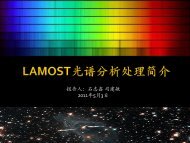
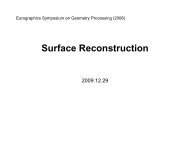
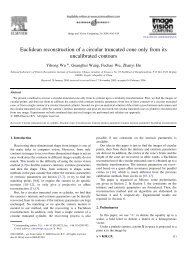
![Accurate, Dense, and Robust Multi-View Stereopsis (PMVS) [1,2,3]](https://img.yumpu.com/19388840/1/190x135/accurate-dense-and-robust-multi-view-stereopsis-pmvs-123.jpg?quality=85)
